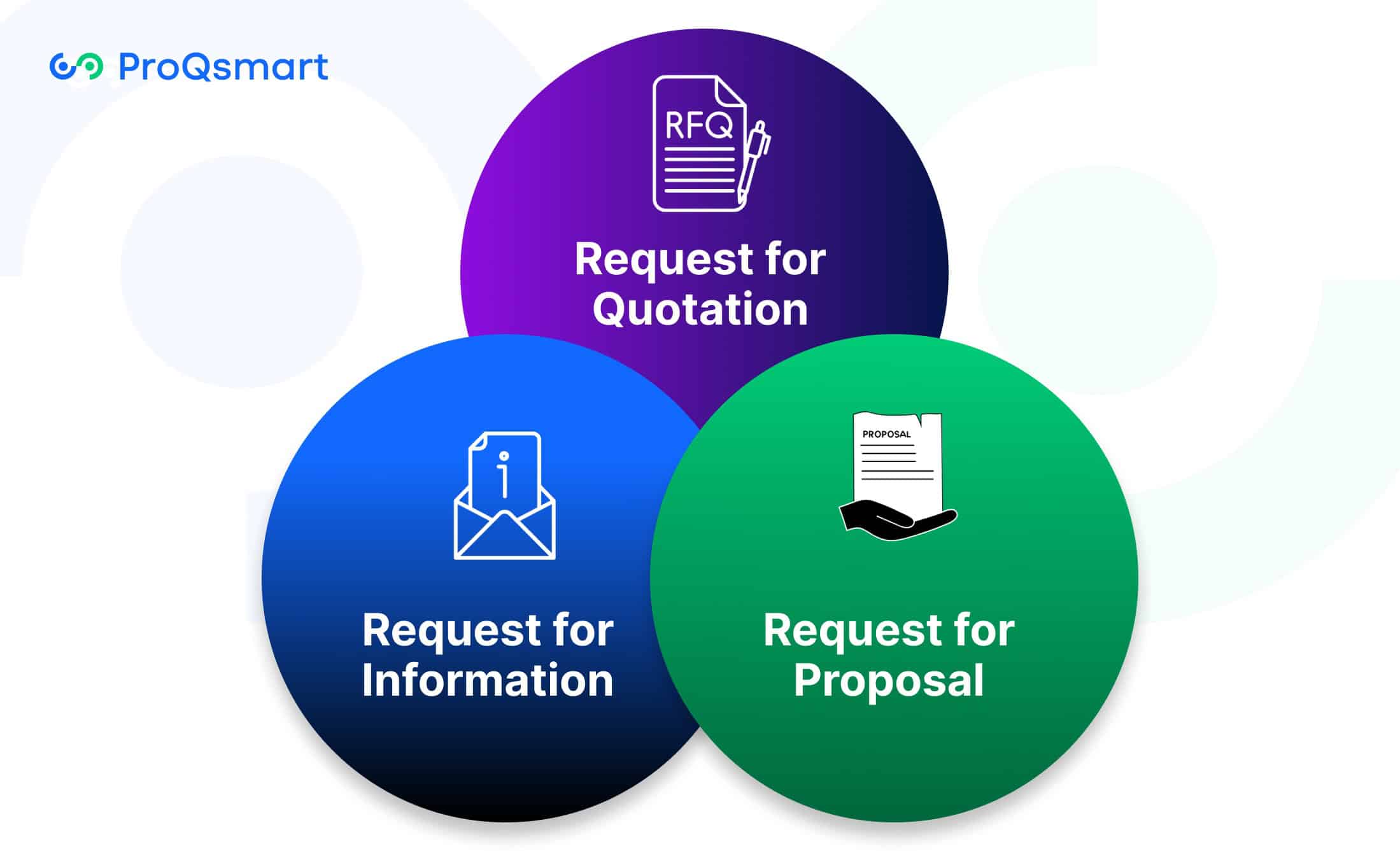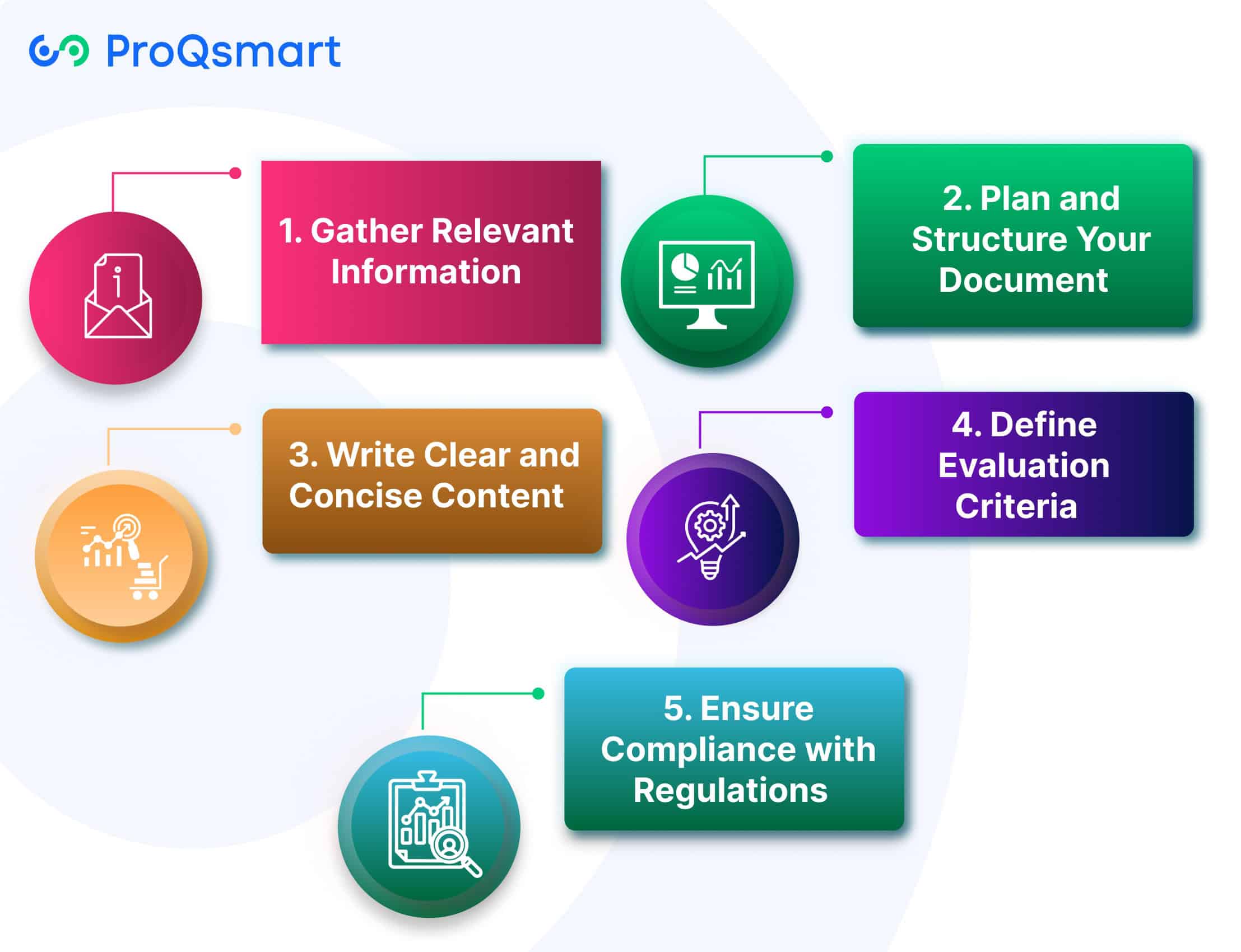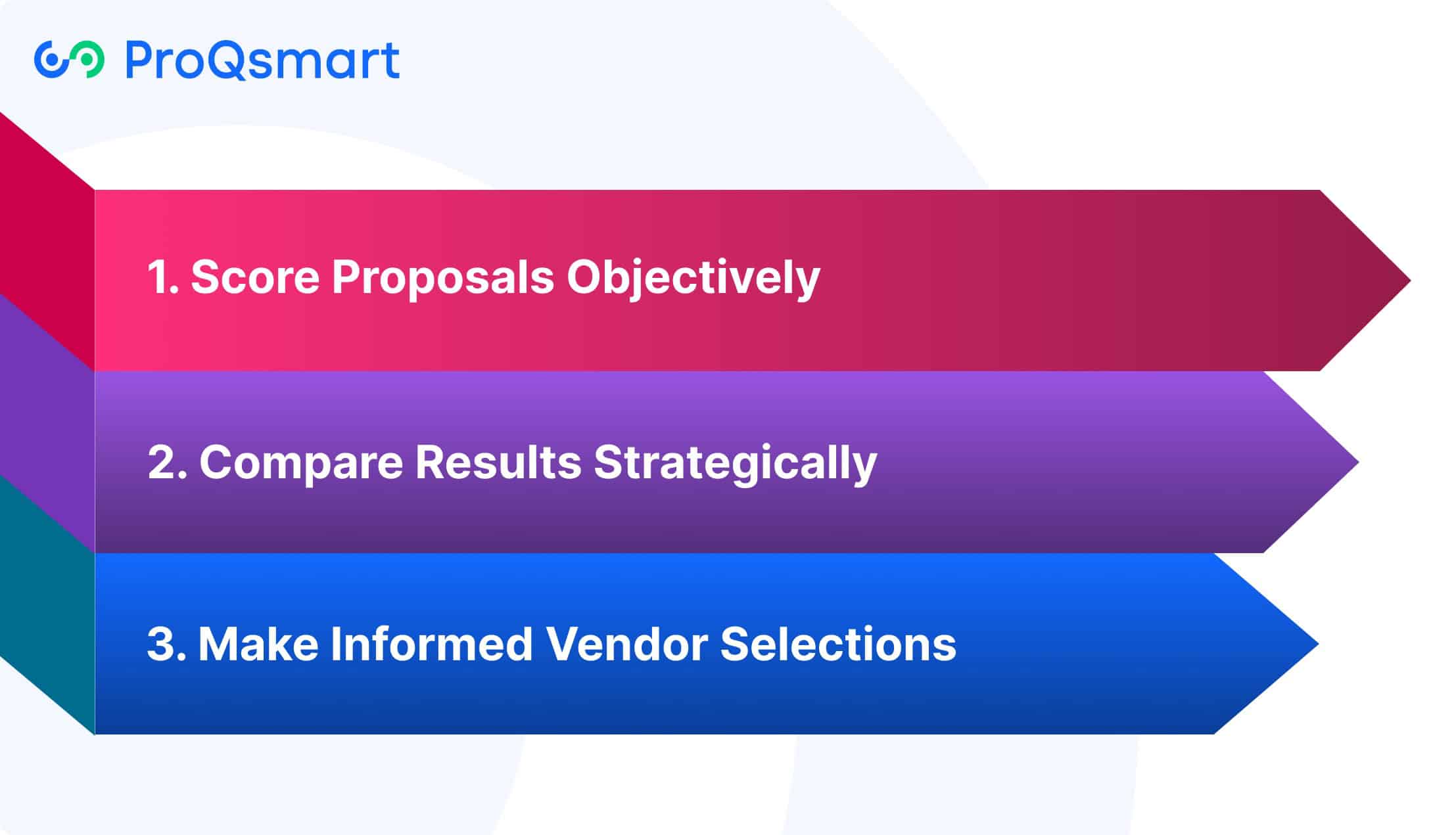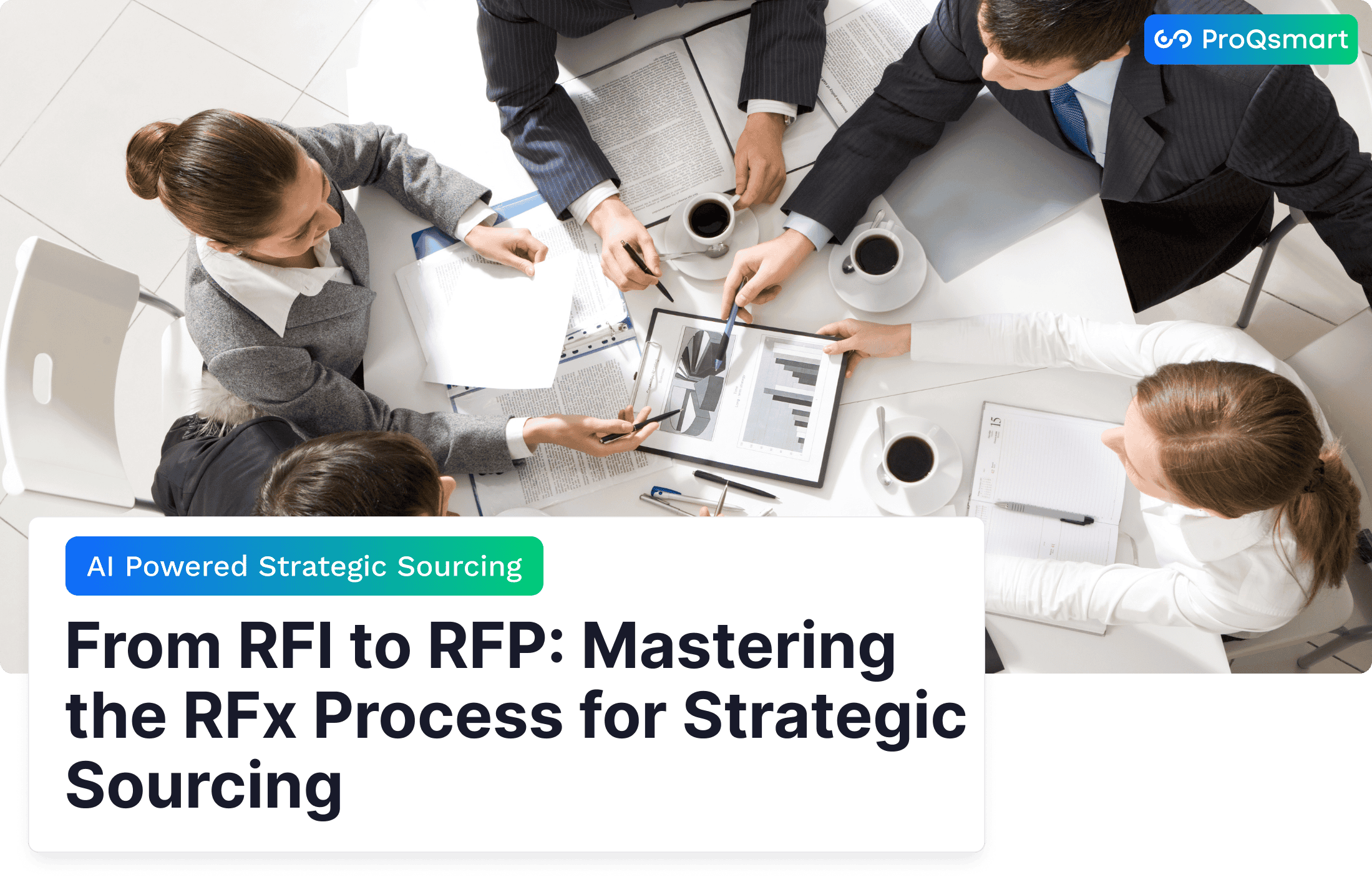RFx includes all types of procurement processes like Request for Proposal (RFP), Request for Quotation (RFQ), Request for Information (RFI), etc. These processes are an opportunity to gather information, proposals, or pricing from potential suppliers.
These processes are invaluable in allowing your organization to make informed sourcing decisions by standardizing supplier communication and evaluating options against established criteria. RFx simplifies procurement workflows, improving transparency, saving time, and minimizing risk in the supplier selection process.
By clearly defining requirements and expectations, RFx enables businesses to compare suppliers objectively and select the best fit for their needs. Additionally, it facilitates adherence to internal policies and external regulatory requirements.
Whether procuring materials or professional services, mastering the RFx process is indispensable for maximizing procurement strategies and realizing more cost-effective outcomes. In this article, we will delve into the intricacies of the RFx process, exploring advanced strategies and best practices that can help organizations optimize their procurement efforts and drive strategic sourcing success.
RFx in Procurement
RFx stands for Request For whatever, and it covers a ton of different requests. Some of the more frequent ones are RFP (Request for Proposal), RFQ (Request for Quotation), and RFI (Request for Information). Each type addresses a specific need.
- RFPs request elaborate proposals from firms for complex, costly projects.
- RFQs focus on the prices and cost-related information.
- RFIs are used to collect preliminary information to determine which vendors to invite to compete.
Getting a handle on these definitions is key to proper and proactive supplier engagement. If you don’t take your time in the RFI stage, you’ll find yourself with muddled requirements. This confusion will considerably complicate the evaluation process.
A clearly defined RFx makes sure you’re getting all the detailed information you need from suppliers, setting the stage for smart decision making.
How RFx Impacts on Procurement Practices
RFx is a key component of procurement, facilitating better decision-making with a complete view of suppliers. It encourages competitive bidding among service providers to the public sector, which frequently results in lower pricing and higher quality of service.
For example, when narrowed down to three to six qualified vendors, RFx can be much more efficient and targeted. Centralizing the RFx process with tools like ProQsmart simplifies data collection and scoring, allowing procurement teams to prioritize strategy over administration.
In addition, RFx enhances compliance and risk management by providing assurance that all activity is consistent with organizational policies and requirements. Automated platforms take this even further, minimizing human error and ensuring evaluators are held to uniform evaluation criteria.
Only twenty-two percent of procurement professionals have fully adopted RFx tools. This is a testament to how adopting new technology can streamline workflows to deliver better strategic outcomes.
Types of RFx Documents

In procurement, RFx documents are indispensable tools for expediting sourcing workflows. They help to ensure accountability by outlining specific expectations while encouraging open and honest communication between buyers and suppliers.
Let’s take a look at each type of RFx document and how each one is uniquely built for specific purposes, providing unique value to organizations and procurement professionals alike. Below is a table summarizing the key RFx types, their purposes, and notable characteristics:
|
RFx Type |
Purpose |
Key Characteristics |
|---|---|---|
|
RFI |
Gather preliminary information about suppliers |
Broad focus, no obligation to award a contract, explores market capabilities |
|
RFQ |
Obtain detailed price quotes |
Price-focused, requires clear specifications, helps finalize costs |
|
RFP |
Solicit detailed proposals for specific projects |
Comprehensive, evaluates technical solutions, includes project scope and requirements |
Request for Information Overview
An RFI serves as a discovery tool – a means to gather high-level information about potential suppliers or solutions, which is essential for informed purchasing decisions. This document is particularly valuable during the initial stages of strategic sourcing, enabling organizations to explore market conditions, understand supplier capabilities, and plan for future procurement needs using a structured approach.
For instance, a construction firm could publish an RFI to gather recommendations on sustainable materials from various suppliers. RFIs typically include questions about a supplier’s relevant experience, technical capabilities, and required certifications, which can help mitigate compliance risks.
It’s important to remember that an RFI is not an award of a contract. This alone would make it a low-risk step in the procurement process. ProQsmart allows RFIs to promote collaboration and transparency in real-time, so procurement teams can get the insights they need quickly and effectively.
Request for Quotation Details
RFQs are all about pricing and typically used when organizations need specific cost estimates for goods or services. These documents lend themselves best to competitive and standardized type purchases and services, like the procurement of office supplies or basic raw materials.
For instance, a factory could send an RFQ to find out how much their specialized steel parts would cost. A well thought out RFQ will have a clear list of specifications, including dimensions or grade of materials, so that all contractors are pricing the same thing.
ProQsmart takes the complication out of RFQ management with automated workflows, automatic compliance checks, and real-time budget tracking. By giving vendors detailed and unambiguous requirements, organizations can eliminate apples-to-oranges comparisons, allowing for real cost comparisons and savings.
"Now you don’t have to worry about drafting your RFQ! We’ve got you covered with our customizable RFQ template. Download it today and simplify your procurement process with ease!"
Request for Proposal Explained
An RFP is superior for more complex procurement needs, especially when utilizing rfx software. It’s often used for complicated projects such as IT systems or construction, where detailed proposals are necessary. This structured approach usually lays out key components such as the project scope, timelines, deliverables, and evaluation criteria.
A new healthcare provider may need to improve its IT infrastructure. To accomplish this, it will be issuing a Request for Proposals (RFP) to solicit bids from technology vendors, ensuring compliance with regulatory guidelines. Common evaluation criteria include technical feasibility, cost, and vendor experience.
ProQsmart makes the RFP process easier and more efficient by centralizing e-tenders and supplier performance data. With its AI-driven digital platform, ProQsmart creates transparency and streamlines the vendor evaluation process, allowing procurement teams to deliver the best value while managing compliance risks effectively.
"Don't let the complexities of RFP drafting slow you down. Download our ready-to-use RFP template and take the first step towards efficient vendor selection and project success"
Understanding the RFx Process
The RFx process consists of RFPs, RFQs and RFIs. This formalized framework is crucial for maximizing excellence in procurement. This process establishes a defined plan for obtaining supplier information and performing evaluations.
It aids in formalizing agreements, providing for transparency and fostering competition. Whether handling basic purchases or intricate procurements, the RFx process allows organizations to use procurement as a tool to help achieve strategic objectives.
Steps in the RFx Process
- Clearly outline procurement needs, including quality standards and performance metrics. One procurement manager from Ahold had a successful experience by including specific requirements in the beginning.
- Develop comprehensive RFx documents to ensure clarity.
- Shortlist 3-6 suppliers that pass your key criteria for more targeted engagement.
- Use predefined criteria to assess submissions, ensuring objective decision-making.
- Finalize the terms so that you get the best possible results.
Proper planning at every stage is imperative for regulatory compliance. A partnership between the stakeholders, empowered by solutions such as ProQsmart, drives efficiency by enabling real-time collaboration and streamlining workflows with powerful automations.
Common Challenges in the RFx Process
Vague requirements, short timelines, and lack of communication frequently derail the results. For example, poorly worded or overly vague specifications can result in misaligned proposals, while lack of communication can undermine supplier relationships.
Integrating workflows on platforms like ProQsmart further alleviates these challenges by automating time-consuming tasks like documentation and confirming compliance.
How to Create Effective RFx Documents

Crafting an effective RFx (Request for Proposal, Request for Information, or Request for Quotation) document is a critical step in procurement. It lays the groundwork for enticing quality responses from suppliers and making sure the planned purchase aligns with your organization’s goals.
When done correctly, an RFx document streamlines the decision-making process, mitigates potential risks, and builds a positive rapport with suppliers. Let’s explore how to do that by adapting best practices.
1. Gather Relevant Information
Before drafting, gather essential details to ensure the RFx aligns with your needs and the market landscape. Key elements to compile include:
- Precise project objectives and scope
- Budget constraints and timelines
- Regulatory requirements
- Supplier qualifications
- Evaluation criteria
Knowing your organization’s priorities and the existing environment of the market you’re going into is key. Or, say you’re sourcing construction materials and understand that price increases fluctuate with the seasons—you’ll mitigate costly overruns.
With diligent research, you can create focused questions that will prompt more precise responses from suppliers.
2. Plan and Structure Your Document
Clear and logical structure makes the RFx easy to follow. Include the following sections:
- Introduction: Outline project background and objectives.
- Scope of Work: Define tasks and deliverables.
- Evaluation Metrics: Specify how proposals will be assessed.
- Submission Details: Provide deadlines and format requirements.
A clear logical flow goes a long way in keeping suppliers engaged and avoiding misinterpretations. For instance, beginning with the overview and finishing with submission instructions makes for an easy-to-follow reading flow.
3. Write Clear and Concise Content
Plain language goes a long way toward making RFx documents work better for all parties. Limit technical jargon that could alienate suppliers.
Be specific in your language, like requesting “10-foot steel beams” instead of saying “large steel beams.” Well defined RFx communication leads to the most relevant, accurate supplier responses, which saves time during evaluations.
4. Define Evaluation Criteria
By determining clear and transparent evaluation criteria up front, you can simplify the selection process. These metrics can be a lot more creative than simple compliance, cost, schedule, and quality.
For instance, scoring proposals on a 1 through 10 weighted system can introduce needed objectivity. Clearly spelled out criteria builds confidence among suppliers, knowing they’ll be judged on the merits of their proposals.
5. Ensure Compliance with Regulations
Following procurement rules and regulations will help shield your organization from legal and reputational scrutiny. For example, in the public-sector world, agencies are required to adhere to very firm bidding rules.
Technology solutions such as ProQsmart make it easier to comply by offering auditable sourcing data. This cloud based platform does more than increase transparency; it automates workflow processes to maintain compliance with internal and external policies and guidelines.
Engaging and Managing Suppliers
Getting supplier engagement right at this stage of the RFx process is foundational to getting the procurement process right. It lays the groundwork for stronger, more meaningful partnerships that can help accelerate efficiency, cost savings and innovation.
By creating a culture of collaboration and clear communication, public organizations can better match supplier capabilities with their strategic goals. This method further provides internal transparency and accountability.
Identify Suitable Suppliers
Consider these criteria when evaluating potential candidates:
- Financial stability to ensure reliability
- Proven track record in delivering similar projects
- Compliance with regulatory and ethical standards
- Technical expertise and capacity to meet requirements
- Compatibility with organizational values and goals
Matching supplier capabilities to your unique needs makes for an effortless procurement experience. For example, if you’re sourcing for a construction project, focus on suppliers who’ll have experience and expertise within that industry.
Engage and manage suppliers. Use market research tools such as ProQsmart to identify qualified suppliers. Through data and trend analysis, you’re empowered to make smart decisions.
Foster Strong Supplier Relationships
Long-term supplier relationships foster quality, innovation, and risk mitigation—all of which contribute to more competitive pricing. Keep communication lines open. Regularly touch base and discuss how to achieve shared objectives to foster long-term relationships.
Building trust involves transparency and collaboration—for example, using tools like ProQsmart to monitor supplier performance fosters accountability and mutual growth.
Encourage Transparent Communication
Open and honest dialogue reduces conflicts and keeps both parties on the same page regarding expectations. This means not only sharing specific RFx requirements but giving detailed feedback.
ProQsmart makes this easy by providing a single platform for all real-time collaboration and document management resulting in a smart and organized RFx process.
Evaluating and Selecting Vendors

This stage of the RFx process is incredibly important. It helps to ensure that our procurement decisions are in line with our organizational goals and that they produce measurable value. A formalized process for evaluating and selecting vendors can lead to better decisions and, even more importantly, it creates an environment of transparency and trust with stakeholders and the public.
Here’s a closer look at key steps and tactics that go into successful vendor evaluation.
1. Score Proposals Objectively
It all starts with creating an objective scoring system – the basis of equitable, reliable vendor evaluation. Start by determining objective evaluation criteria— like value for money, technical competence, ability to meet delivery dates, and adherence to RFP requirements.
Assign weights to each criterion according to what is most important to the organization. For instance, a construction firm might be willing to pay more if it meant reliable suppliers and high-quality materials.
Consistency in scoring is just as critical. Make sure every member of the evaluation team uses the same scoring rubric to eliminate bias. ProQsmart can make this process much faster and more efficient. Its features include automated document management, supplier tracking, and AI-driven scoring.
Common criteria are pricing, experience, past performance, and innovation.
2. Compare Results Strategically
After scoring all proposals received, comparing and contrasting them strategically should lead to finding the best fit. Quantitative factors including pricing need to be tempered by qualitative considerations including vendor reputation and adaptability.
For example, though one vendor can provide the lowest price, another could have better project-specific experience. Working together to create informed collaborative discussions among stakeholders brings depth and value to the comparison process.
Solicit feedback from technical, financial, and operational teams to make sure every angle is covered. Technology platforms such as ProQsmart further improve collaboration by equipping both contractors and owners with real-time data and facilitating discussions between teams.
3. Make Informed Vendor Selections
These data-driven decisions are critical to reducing risks and fulfilling procurement objectives. The insights gained from scoring and performing comparative evaluations should inform the final selection process, helping to ensure that chosen vendors continue to support long-term goals.
For instance, a company that values sustainability may want to work with suppliers who have green certifications. ProQsmart takes the guesswork out of this by automatically monitoring supplier performance and tracking compliance, aligning selections with short-term and long-term strategic needs.
For any organization, aligning vendor capabilities with organizational goals is a crucial first step, one that can make or break project success and cost efficiency.
Advanced Strategies for RFx Optimization
Yet optimizing RFx (Request for X) processes is a key lever for procurement teams to drive strategic value and operational excellence. By taking a more strategic approach and leveraging the right technology, organizations can increase their efficiency and effectiveness. As a result, they enjoyed improved supplier engagement and better decision-making.
Below, we take a deeper dive into some of the most important strategies to help bend these curves.
Leverage Data Analytics in RFx
Data analytics plays a pivotal role in refining RFx processes. By analyzing supplier performance metrics, procurement professionals can identify high-performing vendors, ensuring reliable partnerships. For instance, tracking on-time delivery rates or quality compliance metrics helps set benchmarks for future supplier evaluations.
Analytics can uncover trends and patterns in RFx responses, such as pricing variations or response times, enabling procurement teams to tailor future requests for better outcomes. Tools like ProQsmart streamline this process by centralizing data and offering AI-driven insights.
These capabilities empower teams to make data-informed decisions, improving overall procurement efficiency and effectiveness.
Embrace Digital Transformation Tools
Digital tools are transforming RFx processes, providing powerful features that promote efficiency, communication, and collaboration. RFx management platforms such as ProQsmart make bidding easier with e-tenders, centralized documentation, and automated workflows.
For example, formatting to allow short-form RFPs with ten highly targeted questions minimizes vendor burdens and enhances the quality of the response. Advanced optimization tools, like ProQsmart, allow for centralized data sharing across teams and real-time collaboration with other RFx participants, maximizing team efficiency and effectiveness.
Digital transformation is a journey and staying informed will help make sure that procurement teams don’t fall behind in this fast-paced world.
Implement Innovative Supplier Engagement Tactics
Strategic supplier engagement is essential to win the RFx game. Implement creative strategies. Creative approaches like offering Q&A sessions or sharing robust FAQ documents maintain both clarity for suppliers and goodwill.
Involving no more than three to six potential vendors helps ensure quality responses, and proactive communication fosters healthy relationships. Technology is central to this role, with platforms like ProQsmart making supplier interaction easy, tracking performance simple, and making the workflows clear and transparent.
These strategies result in more efficient RFx management and provide lasting benefits as well, fostering supplier relationships that add greater value over time.
Future Trends in RFx Management
The RFx (Request for X) management landscape is undergoing some dramatic shifts. Technological advancements and an increasing need for agility are pushing this evolution. With more RFx management technologies available than ever before, businesses are adopting forward-thinking approaches to keep procurement processes efficient, precise, and highly competitive.
Here are some of the big trends that are going to continue to transform the future of RFx management.
Role of Automation in RFx Processes
Automation technology is truly revolutionizing RFx workflows, especially in the context of regulatory compliance! It dramatically reduces busywork such as document creation, distribution, and response tracking. Automated systems allow procurement teams to respond faster, a key factor when you’re working with hundreds of suppliers and addressing compliance challenges.
For instance, automating the distribution of RFx documents means they get sent directly to the most qualified suppliers without delays. Automation increases accuracy by minimizing human error in data entry and ensuring compliance with regulations through built-in checks. Tools like ProQsmart, which streamline processes and guarantee adherence to regulatory guidelines, exemplify this trend.
With automation as a foundation, procurement teams can focus their time and energy on strategic decision-making rather than administrative tasks. This next generation of healthcare software not only enhances workflow capabilities but also supports informed purchasing decisions, enabling teams to navigate the complexities of vendor selection with ease.
Integration of AI in Supplier Selection
Artificial intelligence is unravelling the age-old process of supplier selection by making data-driven decision-making the new standard. AI-powered tools can quickly sift through massive amounts of supplier data. They weed out the worst by looking at past performance and compliance records to find the best partners.
For example, ProQsmart uses AI to track supplier performance and forecast risks, making supplier management more efficient. AI further speeds RFx responses evaluation, saving time and labor in the analysis process.
AI-powered RFx tools will have gained wide adoption in most procurement organizations by 2026, creating a more efficient procurement process through improved supplier engagement and experience. This effort helps mitigate risk and improves supply chain resilience, while safeguarding the organization’s competitive positioning in rapidly changing markets.
Conclusion
In reality, mastering the RFx process delivers some very simple, very clear, very measurable benefits. It increases productivity, reduces expenses, and enhances supplier collaboration. With thoughtful RFx documents at the core of the process, you can make more informed decisions and achieve more effective outcomes. Tapping into suppliers’ expertise and data and using sophisticated tactics makes it possible to keep your procurement strategy at the front of the pack.
The future of RFx management is in embracing these trends and technologies. Staying informed and adaptable will help your organization thrive in a competitive market. Procurement isn’t only about the lowest price—it’s about delivering best value, and encouraging innovation.
Get started today towards elevating your RFx approach today. Book a demo with ProQsmart to discover how their innovative solutions can transform your procurement processes and set your organization up for long-term success.








